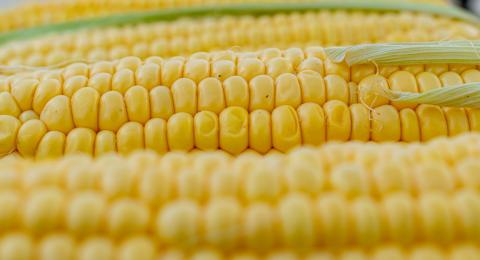Sweet corn is a popular vegetable and is relatively easy to grow. Among market gardeners throughout New England, about half of the vegetable acreage is devoted to sweet corn. The average yield for a home garden is about one-two ears per plant.
Varieties & Types
Sweet corn ears may have all yellow, all white, or bicolor (a mixture of yellow and white) kernels. Bicolor varieties are most popular in New England, but the quality of all of these are excellent and depend on the specific variety, the growing and handling conditions, and on personal preference.
Sweet corn kernels are sweeter than field corn varieties because of a mutation at the sugary locus (su). After harvest, the sugar converts into starches, and the kernels become tougher and less sweet. The traditional (su) sweet corn varieties become starchy relatively quickly after harvest (hence the traditional recommendation to get the pot of water boiling before you harvest the corn!). Sugary-enhanced varieties (se or se+) varieties accumulate more sugar than the (su) varieties, and super-sweet (sh2) varieties are the sweetest of all, with the sugars converting to starches much more slowly than with other types. If super-sweet varieties cross-pollinate other types of corn, the quality of both is reduced. Cross-pollination can be prevented by distance and/or windbreaks, or by planting varieties of very different maturity dates so that they do not bloom at the same time. It is not necessary to isolate sugary (su) or sugary-enhanced (se) varieties from one another.
Growing Conditions
For maximum growth and yield, sweet corn should receive full sun. Soil temperature must be at least 50°F for germination and growth, but 60-85°F is ideal. Sweet corn that has germinated can withstand light frosts because the growing point is protected by the outer leaves, but it is important for the soil to be warm enough to allow germination. It is possible to transplant corn successfully. For transplant, 1-2 seeds should be sown in cells that are large enough so that it does not become rootbound, and plants should be transplanted outdoors within 10-14 days of seeding.
The ideal soil for corn is well drained and fertile, with a pH of 6.0-6.8. As a general rule, plant early corn in light soil (sand or loam) and later corn in heavier soil (silt or clay), when there is an option. Light soils warm up faster than heavy soils, so seed germinates more readily. In hot midsummer conditions, heavier soils have the advantage of holding more moisture than lighter soils.
Sweet corn needs ample water from germination to harvest, but the most critical period for water is about 2 weeks before silks form. Aim for 1 inch of water per week, and supplement natural rainfall with irrigation as needed.
Fertilization
Test soil before planting to determine the amount of lime and fertilizers needed. Soil testing can be done through a number of private and public labs. UNH Cooperative Extension offers this service. Forms and instructions are available on our website, or you can call our Info Line at 1-877-EXT-GROW (1-877-398-4769).
Aged manure or compost incorporated the fall prior to planting will provide nutrients and increase water-holding capacity. Generally, corn needs the equivalent of about 25 lbs of 10-10-10 fertilizer per 1,000 square feet. Equivalent rates of other synthetic or organic fertilizers can be used instead of 10-10-10. Fertilizers should be thoroughly incorporated into the soil before planting. When sweet corn is 15 to 18” high, it may benefit from sidedressing with nitrogen fertilizer at a rate of approximately 2.5 lbs of a 10% nitrogen fertilizer (or the equivalent) per 100 feet of row. Spread the fertilizer between the rows or on either side of a single row and lightly incorporate it into the soil.
Planting
Corn is pollinated when wind currents carry the pollen from the tassel to the silk. Pollination is essential, since each kernel develops only when a pollen grain lands on the silk attached to that kernel. While it is possible for corn to be pollinated effectively when planted in a single row, planting several short rows in a block formation increases the likelihood of successful pollination.

Rows should be spaced 2½ - 3 feet apart. Plants should be spaced 8-10 inches apart between plants. For early plantings, seeds should be no deeper than 1 inch. For later plantings, plant seeds 1-2 inches deep to ensure adequate moisture contact.
Each corn planting will be mature for only a short time: 7-10 days. For a continuous supply of corn throughout the summer, plant a small amount of the same variety every 7-10 days or simultaneously plant varieties with different dates to maturity.
Pest Management
Weeds
Broad-leaf weeds such as lambsquarter, pigweed, purslane and galinsoga, and grasses such as quackgrass and crabgrass are strong competitors of sweet corn. Weeds can be controlled by using mulches of black plastic or straw. For black plastic, lay the mulch before planting, punch small holes through the plastic and push the corn seed down to the appropriate depth. Plants will grow through the holes. For straw mulch, apply after the plants are 4-5 inches high. Shallow cultivation or hand-hoeing are also effective ways to control weeds. The best time to kills weeds is when they are very small, so frequent shallow cultivation is the most effective method.
Insects
The European Corn Borer and the Corn Earworm are two insects that attack sweet corn. Corn borers usually occur twice, in mid-June to early July and again in mid-July to September. Corn earworms occur during this later time period. In small garden plantings, these pests may not occur in a given year, and they may not require management. For more information about integrated management of these pests, please see the publication Integrated Management of Sweet Corn Insects in New Hampshire. Biological and chemical control strategies should be based on the presence of the insects, which can be determined by trapping. For more information, see the publication Setting up Traps to Monitor Sweet Corn Insects in New Hampshire.
Diseases
Sweet corn is generally free of serious diseases. Occasional a grayblack mass appears on the ears. It is caused by a fungal disease known as smut. The best control is to cut off the ear and dispose of it.
Birds and Other Verterbrates
Germinating corn is often pulled up by birds or crows as they search for the kernels. One control method is to cover the planted rows with polyester rowcovers (available at most garden centers) at the time of planting. Secure edges with rocks, soil or pins, and leave enough slack for the corn to grow. Remove after 3-4 weeks when the plants are too large for the space under the cover. Ripening corn is a favorite food of raccoons. Electric fencing with two relatively low electrified strands (6” and 12”) is an effective way to exclude raccoons from sweet corn plantings. The fence should be installed (and turned on) before the corn is ripe, and it is important to keep the area underneath the fence clear of grass and weeds that can ground it out.
Harvest and Storage
When sweet corn is ready to harvest, ears are plump and the silks have turned brown and started to dry up. You can test for maturity by gently peeling back the husk to check kernel size.
The temperature at which sweet corn is harvested and stored can have a dramatic effect on eating quality. After harvest, sweetness rapidly declines as the sugar in the kernel is converted to starch. This conversion is accelerated by high temperatures. For example, the rate of sugar loss is 10 times greater when corn is held at 70°F than at 32°F. Although super-sweet types retain sweetness much longer than other types, it is important to harvest all types of corn in the early morning or late evening when temperatures are cool, and to refrigerate it to maintain quality.
Extension Services & Tools That Help NH Farmers Grow
Newsletters: Choose from our many newsletters for production agriculture
Receive Pest Text Alerts - Text UNHIPM to (866) 645-7010

